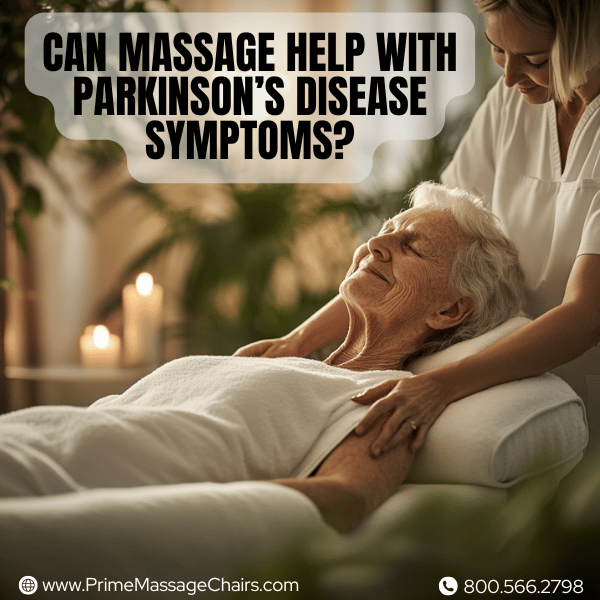
Can Massage Help with Parkinson’s Disease Symptoms?
Can massage help with parkinson’s disease symptoms? Many people living with Parkinson’s may explore massage therapy as a potential way to ease muscle stiffness and improve relaxation.
This blog will discuss how massage could potentially make life better for those with Parkinson's.
Keep reading to learn more.
Understanding Parkinson’s Disease Symptoms
Parkinson's disease may affect how a person moves and feels.
It may bring with it shaking, muscle tightness, and slow movements for some, while others could feel very tired, anxious, or have trouble sleeping.
Motor Symptoms: Tremors, Rigidity, and Bradykinesia
According to the Parkinson’s Foundation, approximately 70-90% of people with Parkinson's may experience tremors as a primary symptom.
These shakes could be a big problem and may make life tough. Besides tremors, muscle stiffness and slowness in movements, bradykinesia, could also trouble those with the disease.

This trio of motor symptoms may greatly reduce the quality of life for patients. Motor symptoms like tremors, rigidity, and bradykinesia could significantly impact daily tasks.
These issues may mean that simple actions become hard or take longer. Walking might not be smooth, and writing could become a challenge.
Because these symptoms may tend to worsen over time, finding ways to potentially improve them is key for living better with Parkinson's disease.
Non-Motor Symptoms: Fatigue, Anxiety, and Sleep Disorders
Many people with Parkinson's disease, may experience non-motor symptoms.
These could include feeling very tired, being anxious, and having trouble sleeping. Problems in the brain related to dopamine may cause these symptoms.
According to research published in the National Library of Medicine, sleep disturbances are highly prevalent in Parkinson’s disease, potentially affecting up to 98% of patients.
These disturbances could include insomnia, excessive daytime sleepiness, and REM sleep behavior disorder.
These symptoms may make life hard for people with the disease. They could deal with stress and depression too.
Getting a good night's sleep might become tough for so many, making their days harder to get through.
This article is for informational purposes only and should not be considered medical advice. Always consult with a healthcare professional before starting any new therapy.
How Massage Therapy May Benefit Parkinson’s Patients
Massage therapy could make a difference for people with Parkinson's disease. It may help relax tight muscles and ease movement, making daily tasks a bit easier.
Reduction of Muscle Stiffness and Rigidity
People afflicted by Parkinson's disease may frequently grapple with muscle rigidity, thereby complicating their movement.
Massage therapy, could possess potential in relieving such muscular stiffness.
Due to improved blood circulation from massages, tight muscles may experience relaxation.
A variety of massage techniques could be effective for this issue.
Consistent massage sessions may contribute significantly to combating the stiffness associated with Parkinson's.
Such massages could aid in facilitating easier movements and also contribute to enhancing the individual's quality of life.
Alleviation of Tremors
Massage therapy could show benefits for Parkinson's disease, especially in calming tremors.
Neuromuscular therapy (NMT) has been recognized for its potential to help reduce muscle stiffness and promote relaxation in individuals experiencing movement disorders.
Patients have noticed more control over their movements.
This improvement may be clear in both how they hold themselves and how they move when doing tasks or just sitting still.
The therapy could help ease muscle tightness, which often makes tremors worse in people dealing with Parkinson’s disease.
Promotion of Relaxation and Stress Reduction
Regular massage therapy may serve as a helpful aid for relaxation and stress reduction for individuals with Parkinson’s disease.
Some research suggests that even brief massage sessions could help increase relaxation and mental well-being.
Massage therapy extends beyond just the physical perks; it may significantly contribute to mental wellness by potentially reducing anxiety and depression levels.

Managing stress could be important as it may directly impact Parkinson’s-related symptoms, making them less severe or more manageable on good days.
Massage therapy is not a replacement for medical treatment. Please consult a healthcare provider before incorporating massage into your care plan.
Types of Massage Techniques for Parkinson’s Disease
Swedish Massage
Swedish Massage may help with muscle soreness, joint stiffness, and tremors. It could make movement easier and provide relaxation, potentially leading to better sleep.
This type of massage consists of long, gliding strokes that promote circulation and ease muscle tension.
Many individuals report a sense of calm and improved flexibility after Swedish Massage sessions, which may be beneficial for those dealing with Parkinson’s-related movement difficulties.
Thai Traditional Massage
Thai Traditional Massage may support muscle strength and flexibility. It could be beneficial in improving movement for people with Parkinson’s.
This massage technique involves stretching, gentle pressure, and deep breathing exercises, which may enhance mobility and reduce discomfort.
Some individuals find that Thai massage encourages better posture and stability, potentially aiding in daily movements.
Neuromuscular Therapy
Neuromuscular Therapy may help in reducing tremors and muscle stiffness. It could provide relief alongside other conventional treatments.
This specialized technique targets trigger points and areas of muscular dysfunction, promoting deep relaxation.

By focusing on specific muscle groups, neuromuscular therapy may assist in improving motor control and coordination, allowing individuals to engage in daily tasks with greater ease.
Preparing for a Massage Therapy Session
What to Expect During a Session
- A massage therapist could adjust techniques based on the needs of individuals with Parkinson’s.
- Sessions may include gentle pressure, kneading, and rhythmic movements to enhance comfort and relaxation.
- The therapist may also use different techniques, such as light stretching, to improve circulation and flexibility.
- Sessions could last anywhere from 30 minutes to an hour, depending on the individual’s preferences and needs.
- Patients may experience a soothing environment with soft music, dim lighting, and calming scents, which could contribute to relaxation.
- Communication with the therapist is key to ensuring that the techniques used are comfortable and beneficial.
- Adjustments may be made at any time to match personal comfort levels.
Choosing the Right Massage Therapist
It is important to select a therapist trained in working with neurological conditions.
Therapists with experience in Parkinson’s disease may better understand the unique challenges associated with muscle rigidity, tremors, and mobility limitations.

Patients should communicate their needs and comfort levels before beginning therapy.
Discussing any pain points, sensitivities, or areas requiring extra care could ensure a positive experience.
Checking a therapist’s credentials, reading reviews, and seeking recommendations from healthcare providers could also help in finding the right professional.
A good therapist may be willing to adapt their techniques to suit the individual needs of each patient.
How Massage Chairs Could Help with Parkinson’s Symptoms
Benefits of Massage Chairs for Parkinson’s Patients
Massage chairs may provide an accessible and convenient option for individuals with Parkinson’s disease to receive regular therapeutic relief.
These chairs offer various massage techniques, such as deep tissue and vibration therapy, which could help reduce muscle stiffness, improve circulation, and promote relaxation.
Enhancing Comfort and Mobility
Using a massage chair may aid in alleviating common Parkinson’s symptoms such as muscle rigidity and discomfort.
The gentle pressure and rhythmic movements could help stimulate blood flow, making movement easier and potentially reducing tension in affected muscles.
This at-home therapy option could allow patients to experience relief without the need for frequent visits to a massage therapist.
Supporting Overall Well-Being
Beyond physical benefits, massage chairs could contribute to mental relaxation and stress reduction.
Many Parkinson’s patients find that regular use of a massage chair may help them manage anxiety and improve sleep quality.
By integrating massage chairs into their routine, individuals may experience a greater sense of well-being and comfort in daily life.
FAQs
Can Massage Therapy Help With Parkinson’s Disease Symptoms?
Massage therapy may help reduce muscle stiffness and promote relaxation, though results can vary for each individual.
What Are the Benefits of Using a Massage Chair for Parkinson’s?
Massage chairs could help improve circulation, reduce muscle tension, and offer a convenient way to receive regular therapeutic relief at home.
How Often Should a Parkinson’s Patient Use a Massage Chair?
The frequency of use may depend on individual comfort levels, but some patients find that regular sessions, such as a few times a week, provide the most benefits.
Are There Any Risks Associated With Massage Therapy for Parkinson’s?
While massage therapy is generally safe, individuals should consult a healthcare provider to ensure it is suitable for their specific condition.
Can Massage Therapy Replace Medical Treatment for Parkinson’s?
No, massage therapy should be used as a complementary approach alongside medical treatment, not as a replacement.
Conclusion
Can massage help with parkinson’s disease symptoms? Many individuals with Parkinson’s may seek massage as a complementary therapy to help with relaxation and muscle discomfort.
It could ease muscle tightness, lower worry, and help with sleep.
For those looking for relief from Parkinson's symptoms, massage could offer a supportive approach, though individual results may vary.
Disclaimer:
We do not provide medical advice. The content of this article, including text, graphics, and other material, is for informational purposes only. It is not intended to be a substitute for professional medical advice, diagnosis, or treatment. Always seek the advice of your physician or other qualified health provider with any questions you may have regarding a health condition. Never disregard professional medical advice or delay in seeking it because of something you have read in this article or on our website.
